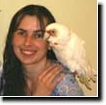When Learning to Use Your Microscope to Determine Illness in Your Birds...
Kristen Reeves, Meadowlark Farms Avian Supply, Inc.
You've decided you want to do everything possible to eliminate illness in your flock, and determine if your bird is sick or merely acting "down". You've made the decision to purchase a quality microscope, and now you want to know what you are looking for! How should you really go about it???
BEFORE ATTEMPTING TO USE YOUR MICROSCOPE -
Before you attempt to view ANYTHING under your scope, you must FIRST know how your scope works. Once you get it home, read the ENTIRE manual. If there is no manual because it is an older scope, go out to the Internet and search for the scope. You'll often find links to old manuals out there!
Once you have a good understanding of how the scope works, put it together and start playing with EVERY single function. Play with the light intensity, play with the focus, play with the condenser to get a feel of how the light changes are you raise or lower it. If you have extra irises, open and close them slowly to see the difference in light.
Once you get a slide on the table, you'll use a combination of fine focus and light to bring your specimen into focus! The amount of light used can make the difference between seeing something or seeing nothing at all. Too much will wash out super fine, clear or pale organisms, while not enough will be too dark to see fine details.
It takes practice, so it's best to practice FIRST, before you need it in an emergency!!
You also want to be certain that once your scope is set up, it is on a LEVEL surface. If it isn't, you'll get a LOT of Brownian Motion. Brownian Motion is movement on the slide - most of which will move all in the same direction if the scope isn't level - it is also random movement of the particles bouncing off one another. If your scope isn't level, EVERYTHING will slide to one end of your slide and you won't be able to see what is moving in an opposite or random direction, away from the rest of the sample. It's those random movements you want to hone in on, so a level scope is a must!
VIEW EVERY FOOD ITEM YOU FEED YOUR BIRDS FIRST -
It is very important to know what goes in so you can recognize what should come OUT!!! Many of the foodstuffs we feed our birds look like pathogens once they pass through the bird. You need to be able to differentiate between what should be there and what shouldn't.
After you are comfortable with the scope itself, you’ll need GLASS slides and cover slips. If you are getting some with the scope, you’ll be all set. If not, you’ll need to purchase some along with some plain Saline.
Like humans, birds are made up of about 66-70% water. Because of this, most items in a birds system will respond positively to Saline and live long enough to view it under the scope. Most motile flagellates, like the various protozoa we may see, require not only a wet environment, but a warm one. They will die quickly after leaving the body. But they are not killed off by Saline and the heat from the scope light will keep them warm enough to view when combined with the Saline - this is why I choose Saline over distilled water or tap water to prepare my slides.
You want GLASS slides because plastic tends to have minute imperfections that look huge under the scope and will often mislead you. Plastic also absorbs bacteria. Glass can be washed and reused if you are careful. I don’t throw away a glass slide until it is too scratched to see the poop anymore! Same with cover slips - but you must be VERY careful reusing the covers. They are super fragile and break easily – and will cut you to shreds if you aren’t careful!
And IF you ever want to "fix" a slide by heating it (primarily for Gram's Stains - that's another story for another day), you don't want plastic. It WILL melt!
On to the food & viewing...
The first thing I tell my students to do BEFORE ever looking at poop samples, is to look at every single item you feed your birds under the scope.
Crush up seed as fine as possible, add a drop of saline, then take a peek. If you feed your birds fresh greens or fruit, smash them up individually to nothing more than juice and take a peek. Note the difference between fruit cells and vegetable cells - they are VERY different! If you offer them egg, look at it under the scope! Spirulina, Kelp, grit, charcoal, cod liver oil, Turbobooster, apple cider vinegar, etc. Even any water supplements you may give them (no need to add saline here)! If you can see what everything looks like BEFORE it goes into the bird, it will REALLY help you to determine what is coming OUT of the bird!
Take pictures with a digital camera through the scope and label them with the name of the food so you can compare when you see something you don’t recognize.
Some food items look like pathogens but are merely pollen or undigested starch granules. Items like diatomaceous earth can look like every single pathogen there is because it has so many shapes!
In time, you'll recognize and differentiate between food stuffs that belong there, and pathogens that do not. I’ve done that so often here than I can recognize which seeds my birds are eating merely by the cellular structure of the plant material in the droppings – at least in most cases!
Take your time and get to know every item you feed your birds. It will save you from panic in the future!
ONCE YOU HAVE A GOOD UNDERSTANDING OF WHAT THE FOODSTUFFS LOOK LIKE -
Once you've looked at EVERYTHING you ever feed your birds, you can then begin to look at their droppings under the scope.
At this point, you want to again photograph what you see and label it for future reference. If you notice certain food stuffs, get a photo and save it so you can compare to anything you don't recognize. If you see something you DON'T recognize, photograph it and label it for additional research.
When choosing your first fecal sample to view, pick one that looks completely normal with nice, tight, fecal portion, and obvious white urates at one end. The color will always be dictated by what the birds are being fed, so it is a bit difficult to tell you what color the dropping should be. You should know what is normal for YOUR birds. Choose what looks the most normal!
Collect the sample with a cotton bud or toothpick. If I want more of the "liquid" portion, I'll use a cotton bud. But if I just want the fecal portion, I will use a toothpick.
To release the liquid portion from the cotton bud, hold it over your slid and slowly add one or two drops of Saline, allowing what drips off to land on your slide. THIS is how you will find protozoa and/or anything in the urine or wetter portions of your samples.
When using a toothpick, select your sample then collect ONLY the fecal portion. Try to avoid the "white" (urates). Urates muddy the sample, and unless you are looking for something specific, such as a kidney issue, there is no need to put urates on your slide. They will often do nothing more than cause confusion - even for me, and I've been doing this a LONG time!
When creating the slide with a sample from a toothpick, "roll" the sample onto the slide and spread it out to a consistency that when the Saline is added, it will be spread relatively thin. If your sample is too thick, you won't be able to see movement or the bulk of the moving organisms will be hidden within the fecal matter.
The bulk of what you'll find will be seen in the "poop free zones". The areas between blobs of fecal matter. There will be NORMAL background bacteria - super tiny, often spherical dots that jitter - these are completely normal and should be seen in relatively small amounts in every sample. They are usually singular and separate. When you see "chains", or "clusters" of 5 or more, you are more than likely dealing with a pathogenic bacteria such as Streptococcus or Staphylococcus. Again, these will be SUPER tiny.
Most pathogens affecting our birds can be easily recognized without an electron microscope and easily seen with 100x up to 400x magnification. Any more magnification and EVERYTHING begins to look like a sea monster. Don't do that to yourself!! Stick to 100x & 400x until you have learned the basics!
Rules of thumb:
- You must FIRST know what is NORMAL for your bird to know when their droppings are OFF.
- If it has COLOR, it's probably NOT pathogenic. Most pathogens are clear or look "hollow".
- If there are MANY of the same item and they are ALL shaped the same and are the same size, they may be pathogenic. Items like urates tend to be multiple sizes. But they can be confused with pollen, worm eggs, and coccidia. But urates often appear black or dark grey under the scope. They are almost solid and look somewhat like a chrysanthemum with a chambered center.
- If it MOVES, it is probably pathogenic. But there is a fine line. If you were to look at Brewer’s yeast or Dr. Rob Marshall’s ePowder under the scope, they’d look very much like red blood cells or pathogenic yeast. AND if the yeast is live, it will “jitter”. There are background bacteria that are NORMAL that are usually super tiny spheres moving around in what I refer to as the “poop free zone”, but there may be larger items like rod-shaped bacteria, protozoa, or even chaining circular bacteria that can be pathogenic. It’s a matter of being able to tell the difference - looking at foodstuffs FIRST and getting to know them really makes a difference.
- TAKE YOUR TIME WITH EACH SAMPLE AND LOOK AT EVERY MILLIMETER FROM ONE END OF THE SLIDE TO THE OTHER!!! If you rush through a slide, you may miss something critical. I sit at my scope for HOURS on end. But it matters, so I take my time.
Again, now that you are looking through the scope at an actual sample, you want to practice playing with the light, then the light and fine focus at the same time, move the different irises and additional lenses (if there are any), move the condenser up and down to see how it affects light intensity, adjust the light, etc. You have to know HOW the light affects your sample in order to actually find the pathogens!
What you will see and eventually recognize is bacteria, urates, urine, calcium oxalate crystals (if the bird has Gout or if items you are feeding have chelated and settled in the kidneys like kidney stones), plant material, undigested starch granules, yeast (Candida), protozoa, worms and/or worm eggs, coccidia, pseudomonas, etc. But many of these items look like food items, so it’s really important to look at food FIRST. You can try looking at poop, but it won’t do you any good if you don’t know where to begin ELIMINATING items.
~k





